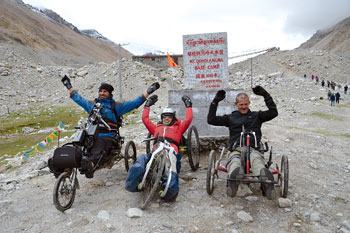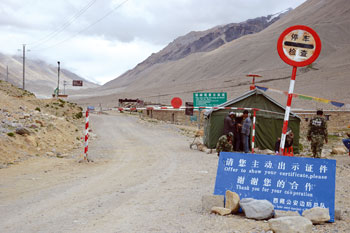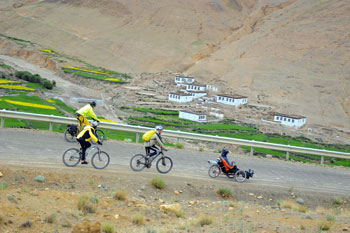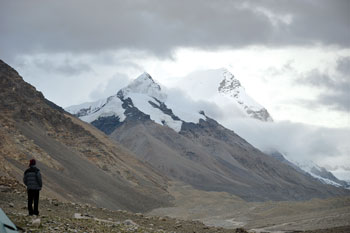Before Catriona Williams had a riding accident that led to a spinal cord injury that paralysed her, she never gave much thought to cycling. But earlier this month she returned from a grueling two-week ride across the Himalaya from Lhasa to Kathmandu via Mt Everest Base Camp.
Her team of 15 cyclists, among whom were three tetraplegics including herself, rode their hand cycles along the old trans-Himalayan trading route in a campaign to raise $1 million to help find a cure for spinal cord injury.

WHEEL POWER (l-r): Neil Cudby, Catriona Williams, and Rob Creagh at Everest Base Camp at 5,200 metres.
Williams was New Zealand’s champion equestrian and had represented her country in competitions all over the world. In 2002 she fell off a horse at a championship and suffered from injuries to her spinal cord and needed a wheelchair to move. Not one to be confined, she started The Catwalk Spinal Injury Trust to raise awareness about spinal cord injury.
The goal this time was to make cycling as difficult as possible by riding down from the roof of the world. None of the participants had hand-cycled for so long at one go and certainly not at such high altitude through rough roads. Before Williams and her team went to Lhasa, doctors had recommended seeking an easier challenge, but they persevered and even returned a day earlier than scheduled.

Check point to enter Everest Base Camp.
“Surprisingly, it was tougher on our able-bodied cyclists than it was for us,” says Williams. “The 100km from the turnoff to Everest Base Camp through Rongbuk was all rough road and was harder for us.”
The team also included tetraplegics fellow-New Zealanders Neil Cudby and Rob Creagh and when they finally got to the Everest Base Camp one of their bikes broke down, so the remaining two towed him to the destination. It was a world-first for tetraplegics to have done the Lhasa-Kathmandu ride. Williams says the feeling of having overcome this momentous task has still not sunk in.

Heading down to Pangla from Rongbuk valley.
“It was a personal goal for the three of us, to see how far our bodies would go,” says Williams. “But the main aim was to raise awareness and money, so that kids who break their necks get help. Even if there is no time for us to fully recover and be able to walk and dance again, we want to make a difference for the next generation.”

Everest appears briefly through the clouds from the campsite next to Rongbuk monastery.
The team raised $600,000 and Williams hopes this will help fund spinal cord injury. Says Williams: “Life is not measured by the number of breaths we take, but by the moments that take our breath away.”
Sunir Pandey
www.catwalk.org.nz
Read also:
Pedal Power
Watch interview of Catriona Williams